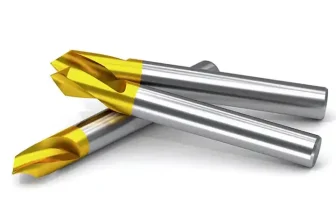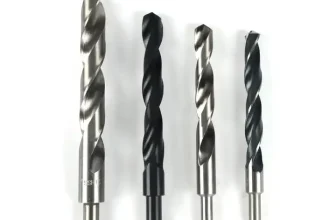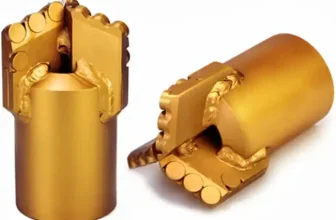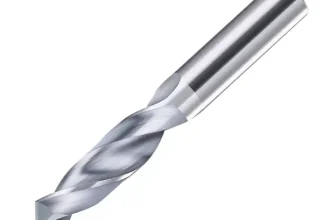Roller bits, also commonly referred to as rock bits or tricone bits,
are a type of industrial tool used in drilling operations. They are
primarily known for their distinctive, rugged design featuring multiple
rolling cones studded with teeth or sharp inserts for penetrating and
crushing hard substances like rocks. Roller bits offer a reliable
solution to various industries that require consistent, high-performance
drilling, such as oil and gas, mining and construction. These drill bits
are renowned for their comprehensive approach to drilling – they cut,
scrape and crush the materials, enabling the users to pierce through the
toughest terrains effectively. The following sections will delve into
the structure, mechanical function, applications, and advancements of
roller bits.
Importance and
application of Roller Bits
Roller bits are crucial components of the drilling industry, serving
as the spearheading entities that bore into the heart of our planet’s
crust. These tools, often known as rock drill bits, are primarily
designed for excavating tough materials in numerous industries. For
instance, oil and gas enterprises employ them to reach hidden pockets of
hydrocarbons beneath the surface, whereas mining firms use them to
extract valuable minerals and ores. They’re also used in constructing
wells, anchorage installations and geotechnical surveys, demonstrating a
broad spectrum of applications in multiple industries. As a result, the
importance of roller bits is inexplicably tied up with strategic
industrial activities, affecting both economic and infrastructural
aspects.
Detailed Description of
Roller Bits
Overview of the
physical structure and material
Types:
milled-tooth and tungsten carbide inserts
Roller bits are intricate and exquisitely designed tools, exhibiting
a physical structure which speaks volumes about their strength and
durability. They are essentially categorized into two primary types:
milled-tooth and tungsten carbide inserts.
Milled-tooth bits, as the name suggests, are designed with
steel-tooth cutters. These cutters are integrated into the cones of the
bit. Each tooth in these bits is milled in a specific design to cater to
distinct functions, such as eradicating the rock or earth during the
drilling process. Milled-tooth bits are typically utilized for softer
formations as they can drill through them at a faster rate due to their
sharpened milled teeth.
On the other hand, tungsten carbide inserts (TCI) are types of roller
bits engineered with carbide inserts pressed into the bit cones. This
results in a rugged exterior which is ideally suited for hard and
abrasive formations. The physical composition of tungsten carbide,
renowned for its supreme hardness and robustness, allows these bits to
retain their sharpness for much longer durations, even amidst the
harshest of conditions.
From the type of steel used in the manufacturing to the material of
the inserts, every aspect of roller bits is meticulously designed to
cater to specific drilling needs and application environments. The
exceptional durability and strength offered by them makes them a
preferred choice across diverse drilling industries.
Size of roller bits
Roller bits come in a range of sizes to cater to the differing
demands of various drilling operations. The size of a roller bit is
identified according to its diameter, which can vary from a few inches
to up to 36 inches, typically following industry standards for specific
applications. When selecting the size of the roller bit, drillers have
to consider the drilling formation, hole size, and type of drilling
equipment available.
The standard design of roller bits involves having two or three
cones, or “rollers,” each equipped with teeth or inserts. The design’s
size directly influences the bit’s capability in dealing with the
compression and shear forces that happen during drilling. A large-sized
bit can handle high drilling speed and tough formation. On the other
hand, smaller bits are favored in scenarios requiring precision and
meticulousness.
In conclusion, the size of a roller bit is critical to its
performance, and choosing the correct size depends on the specific
drilling task at hand.
Mechanical function of
the Roller Bits
Cutting, crushing, and
scraping process
The primary function of roller bits is to facilitate the process of
drilling by cutting, crushing, and scraping materials found under the
earth’s surface. The process begins with the bit being attached to a
drill string. Afterward, a rotational force is applied to the bit, which
then spins and drills into the soil, rock, or other ground material.
Here’s where the unique functions of different types of roller bits come
into play.
Milled-tooth bits are specialized for cutting and crushing processes.
They include numerous steel-tooth cutters arranged around the bit, with
each tooth contributing to bite into the rock surface and break it
apart, effectively carving out the hole.
On the other hand, tungsten-carbide insert bits, with hardened tips
shaped and sized specifically for the task, specialize in the scraping
process. They operate by gouging out grids along the rock surface by
applying intense pressure to chip away the material rather than cutting
through.
In both cases, the rotary action of the roller bit combined with the
downward pressure exerted by the drilling rig results in an effective
and efficient drilling process. Different roller bits are used depending
on the hardness and type of ground material, ensuring the optimal
balance between cutting speed and bit lifespan.
Cooling feature to
prevent overheating
Roller bits function primarily to drill through solid surfaces;
however, this process generates significant heat due to extreme
friction. This heat, if not handled correctly, can damage the bit and
affect the overall drilling effectiveness and efficiency. Therefore,
roller bits incorporate a unique cooling feature to handle this heating
issue.
This overheating problem is taken care of by circulating drilling
fluids commonly referred to as ‘mud.’ These fluids flow within the drill
string and out through the nozzles in the bits. One of its key purposes
includes cooling down the bit and carrying away the cuttings thus
preventing bit-balling—an accumulation of drilled cuttings that can
stick to the bit. This circulation of drilling fluids serves a dual
purpose. It not only keeps the bit cool but also cleans the bottom of
the hole, maintaining drilling efficiency.
Therefore, the cooling feature embedded in the roller bits is an
integral part of their function. It prevents overheating, reduces the
risk of damage to the bit due to excessive heat, and ensures the
efficiency of the drilling operation can be maintained over prolonged
periods. Without this cooling mechanism, drilling processes using roller
bits would be significantly less effective and could result in major
setbacks in industrial applications.
The Role and
Application of Roller Bits
Role of Roller Bits in
drilling
Roller bits, also known as rock bits or drill bits, play a pivotal
role in the drilling process. Their function lies fundamentally in
excavating the earth’s crust to reach the desired resources underneath.
Roller bits work primarily by exerting a combination of axial force and
rotational torque on the surface to be drilled.
Upon contact with the surface, each roller applies the necessary
force and carves out a part of the ground beneath. The rolling action
not only cuts but also crushes and grinds the rock, making it easy to
remove the debris, resulting in a borehole.
The shape and type of the roller bit teeth determine the
effectiveness of the drilling. Milled-tooth bits perform best with
softer formations, while tungsten carbide inserts excel at drilling
through harder, more abrasive surfaces.
In well-drilling activities, the role of roller bits extends beyond
just rock drilling. They contribute to reducing the operation time by
their ability to reach great depths quickly due to their efficient
cutting process. This efficiency can significantly cut down the time and
costs associated with drilling, making roller bits an invaluable tool in
the drilling industry.
An important note is that, despite their robust structure, roller
bits need a continuous supply of drilling fluid. The drilling fluid
keeps the bit cool and removes the cuttings from the borehole,
preventing excess heat and friction that could damage the roller bits
and hamper operations.
Sectors and
Industries where Roller Bits are used
Oil and gas industry
Roller bits play a vital role in the oil and gas industry,
specifically in the process of oil drilling. This equipment is
extensively used in drilling wells in the quest for petroleum and
natural gas. The reason for their widespread use boils down to the
effectiveness and ease they provide in penetrating various types of
geological formations, from soft to very hard rock types found in the
deep underground layers of the earth.
Their practicality is seen in both onshore and offshore drilling
operations. In these drilling projects, the roller bits are attached to
the drill string, and then they are driven into the earth to drill a
hole. The type of roller bit used mainly depends on the composition of
the geologic stratum. For instance, milled tooth roller bits are used
for softer formations, while tungsten carbide inserts are utilized when
encountering harder rock layers.
Roller bits have greatly increased the efficiency and speed of
drilling operations in the oil and gas industry, significantly
contributing to the sector’s growth and capability. Without the
development and use of roller bits, capturing the energy resources
beneath the earth’s surface would be a much more grueling and
time-consuming process.
Overall just as much as the importance of oil and gas to the energy
sector, roller bits play an equally critical role in making the
extraction of these resources possible. To put it simply, roller bits
have become an indispensable tool in the oil and gas industry.
Mining industry
In the mining industry, roller bits are indispensable tools that
significantly enhance drilling performance. Mining involves the
extraction of essential minerals from the earth’s crust, and this
procedure often demands deep drilling processes. Roller bits allow for
the efficient boring of holes as they have the capability to penetrate
even the most challenging geological formations.
Their cutting teeth which are designed to fracture, crush or scrape
the rock faces, help in the extraction of coal, metals, and other
minerals. Owing to their cooling feature, roller bits are less prone to
overheating even when used in extensive drilling sessions, promoting the
longevity of tools and reducing operational downtime. With an increase
in demand for mineral resources, roller bits are expected to continue to
play a critical role in the mining industry.
Construction industry
Roller bits find extensive application within the construction
industry, proving indispensable for a variety of tasks. Their primary
role in this sector is to facilitate the drilling process during
construction, particularly in areas where intensive damage to the
structure needs to be minimized. Their precise drilling capability
ensures a clean hole creation in foundational work, aiding in setting up
strong support structures for buildings.
Moreover, specific construction projects, such as creating pathways
for utilities or drilling for the installation of geothermal heating
systems, heavily rely on roller bits. Their robust design and
functionality allow the effective penetration of heterogeneous earth
materials like rocks, making them ideal for these complex construction
projects.
In highway construction, roller bits play a significant role in road
planing and asphalt milling. By effectively grinding and removing old
asphalt layers, they prepare the surface for a smooth new covering.
Roller bits continue to evolve with the construction industry, meeting
its rising demand for speed, precision, and durability.
It is safe to say that within the construction industry, roller bits
play an integral role. From foundational work to road surfacing, their
precision, power, and versatility significantly contribute to the
sector’s ongoing growth and development.
The
Evolution and Advances in Roller Bit Technology
History of the Roller Bits
Roller bits, also known as rock bits or tricone bits, were first
introduced to the industry in the early 20th century and have an
intriguing history. Although primitive drilling tools date back several
thousand years, the first modern roller cone drill bit was patented by
Howard Hughes Sr. in 1909, leading to the formation of Hughes Tool
Company, a foundation stone in the world of drilling technologies.
This initial design of roller bits was made up of three rotating
cones, each equipped with teeth capable of penetrating hard rock, hence
the names ‘rock bits’ and ‘tricone bits’. The inception of these tools
revolutionized the drilling industry as it tremendously increased the
speed, efficiency, and depth of drilling operations compared to their
predecessor, the fishtail bit.
Over the years, the design of roller bits saw several enhancements,
including the addition of water courses in the mid-1930s for improved
debris removal and bit cooling. Then, during the 1950s, came a
significant innovation with the introduction of tungsten carbide insert
(TCI) roller bits, replacing the earlier steel-tooth technology to
deliver greater durability and cutting performance. The ensuing years
saw further advancements such as sealed bearing structures and complex
geometric designs to improve drill bit life and drilling speed.
While the roller bits have come a long way since their inception,
they continue to evolve in terms of design, materials, and control
mechanisms to cater to the growing demands of various industries and
different strata of the Earth’s crust.
Recent advancements
Enhanced durability
In light of the demanding environments and challenging geological
conditions that roller bits must perform under, durability has become a
key focus in their design and advancement. Recently, the industry has
seen significant progress in enhancing the longevity and wear resistance
of roller bits.
One of the critical advancements is in the materials used; modern
roller bits are now typically manufactured with improved quality
tungsten carbide or alloy steel for more excellent abrasion resistance
and structural strength. Furthermore, manufacturers have found
innovative ways to manipulate these materials, such as using advanced
welding techniques to ensure the inserts are securely fixed, thus
extending the bit’s lifespan.
Another breakthrough in bolstering roller bit durability is the
development of enhanced layouts and designs. Engineers now optimise the
arrangement of the cutting structure to ensure even distribution of the
workload across the bit teeth. This helps to prevent premature wear and
breakage, significantly extending the service life of the roller
bit.
Moreover, the introduction of high-performance bearings has greatly
improved the durability of roller bits. These specialised bearings
reduce friction, ensuring smoother rotation and consequently increasing
the bit’s life expectancy.
Lastly, advanced protective technology such as hardened coating
materials has been introduced. These coatings offer superior protection
against the harsh environment encountered in drilling operations
including high temperatures, abrasive sands, and corrosive fluids.
All these enhancements can lead to significant cost savings for
companies in the long run. As the roller bits can now withstand longer
drill times with less wear and tear, the frequency of bit changes and
associated downtime is decreased considerably.
Increased efficiency
Roller bit technology has come a long way since its inception. One of
the significant advancements in recent times is the remarkable increase
in efficiency. In the quest to maximize drilling performance, companies
have invested time and resources into improving the design and
functionality of roller bits.
The increased efficiency is mainly attributed to advances in the
hydraulic design of these bits. Today’s roller bits are engineered to
channel more fluid to the bit’s cutting interface. This results in a
faster and more efficient removal of cuttings from the borehole, which
speeds up the drilling process significantly.
Moreover, the use of enhanced data collection and analysis tools has
facilitated the creation of highly precise models of rock formations.
These models inform the design and positioning of the teeth or “cutters”
on roller bits, which has greatly improved their efficiency in drilling
through varied and complex geological structures.
Also contributing to the increased efficiency is the use of durable
materials like tungsten carbide, which have prolonged the bit’s working
life. This reduces the need for bit changes and subsequently, the
drilling downtime. In summary, advancements in materials, design, and
data analysis have culminated in a significant efficiency increase in
roller bit technology.
Maintenance
and Safety Measures with Roller Bits
Regular Check-ups and
Maintenance
Regular check-ups and maintenance are an essential part of roller bit
operations. Ensuring that the equipment is in optimal condition not only
boosts performance and longevity but also prevents costly and
potentially hazardous failures.
Primarily, a routine inspection should be carried out to detect any
visible defects like cracks or erosion on the roller bit. The teeth or
inserts require particular attention, as they are the part that does the
drilling and, therefore, most prone to wear and damage. If the teeth or
inserts exhibit excessive wear or damage, a replacement is
necessary.
Besides the visual check, the bearings and seals of the roller bits
also need routine examination. Both components play a vital role in
facilitating rotation and retaining the lubricant respectively, hence
their condition is critical. If not properly maintained, it could lead
to seizing of the roller cones or leakage of the lubricant, which can
impair the roller bit’s performance.
Furthermore, the lubricant’s condition should also be analyzed
regularly. The lubricant, apart from reducing friction, acts as a
coolant preventing overheating of the roller bits. Hence, it should be
replaced at regular intervals to sustain its efficacy.
Post-operation cleaning is yet another aspect of maintenance. After
every use, the roller bits should be meticulously cleaned to remove
drilled cuttings or mud that may have adhered to the roller bits, which
could affect their performance and lifespan.
In conclusion, regular check-ups and maintenance are a pivotal part
of roller bit operations, that can significantly contribute to a safer
and more efficient drilling process.
Safety Measures
Handling and storage
Proper handling and storage of roller bits are crucial steps towards
elongating their lifespan and ensuring safety. First and foremost, it’s
essential to use gloves while handling roller bits to prevent injuries
due to their sharp teeth or inserts. These drilling tools may pose an
injury risk if not handled cautiously due to their bulk and weight.
Hence, appropriate measures should always be enforced when transporting
or loading roller bits.
Storage of roller bits is another fundamental aspect that calls for
meticulous attention. These equipment should be stored in a clean, dry,
and temperature-controlled environment to prevent rusting, corrosion, or
any form of premature degradation. It’s also essential to keep them in
an upright position to protect their cutting structure. Each roller bit
should have its distinct storage space avoiding piling upon each other
to prevent damage.
In addition, it’s also advisable to cover roller bits with a
protective cap when not in use. This protects the drill bit cutters from
dust or any foreign particles. High standard of care should always be
ensured during handling and storage of roller bits to not only guarantee
safety but also save on maintenance and replacement costs.
Correct usage and
precautions
Correct usage and precautions of roller bits are crucial to ensure
safety and prevent any possible mishaps during operations. Utilizing
roller bits properly starts with understanding their limits and being
aware of the manufacturer’s instructions.
Overuse or misuse can lead to excessive wear, damage, and even
accidents. Operators should be trained not only to use the roller bits
effectively but also to recognize the signs of potential problems.
Ignoring unusual vibrations or sounds can result in severe damage to the
bit, the machine, and can pose a risk to personal safety.
Protection of the user and others nearby is paramount during the
operation. It’s essential to wear appropriate personal protective
equipment, such as safety glasses and hand gloves for protection from
debris and metal splinters that can result during drilling.
Operators must also ensure that the roller bit is securely mounted on
the drill before starting the operation. Loose bits can detach during
drilling, causing injuries. It’s advisable to regularly check the
condition of roller bits and fixtures to avoid such instances.
Moreover, it’s also essential to adhere to the right drilling speed
and pressure. Too much speed or pressure can stress the bit, cause
overheating, rapid wear, and even bit breakage. It’s recommended to
start with a slower speed and gradually increase as the bit works its
way into the drilling surface.
Lastly, after operation, the roller bits should be cleaned thoroughly
to remove any debris, cooled down if overheated, and stored in a dry
place to prevent rusting, adding to the life of roller bits.
By strictly adhering to these guidelines, we can help ensure a safer
and more productive work environment that prioritizes both the
functionality and lifespan of roller bits and the safety of
operators.
Conclusion
Recap of
the importance and application of Roller Bits
Roller bits play a crucial role in numerous industries with their
unique design and functionality designed for drilling operations. Their
striking balance of physical robustness and mechanical intricacy enables
them to provide efficient cutting, crushing, and scraping. These tools
are indispensable in sectors such as oil and gas, mining, and
construction, where precision and effectiveness are paramount. The
continuous evolution of roller bit technology promises even greater
durability and efficiency, opening new possibilities for exploration and
resource extraction. Maintaining these tools properly and using them
safely is imperative, ensuring their performance and longevity. With
their wide-ranging applications and constantly advancing technology,
roller bits will undoubtedly continue to play a significant role in
numerous sectors well into the future.
Final Remarks
Roller bits have truly revolutionized various industries by turning
what was once a physically demanding task into a more efficient and
precise operation. In a rapidly advancing technological era, these tools
are a testament to the power of innovation. There’s little doubt that
roller bits have paved new paths in industries such as oil, gas, mining
and construction, and will continue to do so. Their unique design
coupled with advanced materials are a prime example of how engineering
solutions can significantly optimize and transform operational
processes. We can certainly anticipate further enhancements and
improvements in roller bit technology as we move forward.
Future implications of
Roller Bits.
The future implications of roller bits are vast, reaching far beyond
their current applications. As industries continue to evolve, so too do
the demands placed on drilling equipment. This positions roller bits at
the forefront of potential innovation and industrial growth.
Sustainability and efficiency are key focus areas in technical
innovation. Therefore, future roller bit models could harness
energy-efficient designs that enable even faster drilling with reduced
energy use.
Alongside this, with the progression in material science, we may see
roller bits made of more durable materials to withstand harsh conditions
and offer longer life spans. This, in turn, will reduce operational
costs and enhance productivity. Technological advancements may also lead
to the integration of sophisticated sensors onto roller bits to
facilitate real-time performance monitoring and preemptive
maintenance.
There is also a potential for increased use of roller bits in other
yet-unexplored sectors such as renewable energy installations, or space
explorations, where drilling for resources might become necessary in the
future.
In summary, the future of roller bits promises an exciting blend of
sustainability, efficiency, and technological advancements. It will be
fascinating to see how these developments continue to shape the
industries that rely on them.







